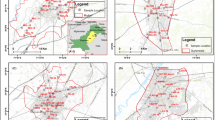Abstract
A hydrogeochemical approach has been carried out in the Mio-Plio-Quaternary aquifer system of northern Sfax to investigate the geochemical evolution, the origin of groundwaters and their circulation patterns. The groundwater samples collected from different wells seem to be dominated by sodium chloride type to sulphate chloride type. Detail analysis of chemical data including the thermodynamic calculations was used to assess that the chemical evolution of groundwater is primarily controlled by water–rock interactions. The values of sodium absorption ratio and electrical conductivity of the groundwater were plotted in the US Salinity Laboratory diagram for irrigation water. Most of the water samples in northern Sfax fall in the fields of C4S1, C4S2 and C4S3 indicating very high salinity and medium to high sodium alkalinity hazard. Thus, groundwater quality is ranging between doubtful to unsuitable for irrigation uses under normal condition, and further action for salinity control is required in remediating such problem. Principal component analysis of geochemical data used in conjunction with bivariate diagrams of major elements indicates that groundwater mineralization is mainly controlled by (1) water–rock interaction processes, (2) anthropogenic process in relation with return flow of NO3-rich irrigation waters and (3) domestic discharges.
















Similar content being viewed by others
References
Ayers RS, Westcot DW (1988) Water quality for agriculture. FAO Irrigation and Drainage Paper No, 29 (Rev 1), Food and Agriculture Organization of the United Nations
Ben Brahim F (2006) Actualisation de l’étude hydrogéologique des nappes phréatiques de Sfax-Nord. Mémoire de Mastère, faculté des Sciences de Sfax
Beni Akhy R (1994) Etude de l'évolution et modélisation mathématique de la nappe phréatique urbaine de Sfax. Mémoire DEA, faculté des Sciences de Tunis, Université de Tunis II, Tunisie, pp 117
Bouri S, Abida H, Khanfir H (2008) Impacts of wastewater irrigation in arid and semi arid regions, Tunisia. J Environ Geol 53:1421–1432
Clement A, Fritz B, Made B (1994) Thermodynamic and kinetic modelling of digenetic reactions in sedimentary basins. Description of the geochemical Code KINDISP. French Institute of Petroleum 49:569–602
Davis SN, Dewiest RJM (1966) Hydrogeology. Wiley, New York, p 463
Durov SA (1948) Natural waters and graphic representation of their compositions. Dokl Akad Nauk SSSR 59:87–90
Garcia MG, Del Hidalgo M, Blesa MA (2001) Geochemistry of groundwater in the alluvial plain of Tucuman province, Argentina. J Hydrol 9:597–610
Grattan SR (2002) Irrigation water salinity and crop production. Publication 8066, FWQP references sheet 9.10. Division of Agriculture and Natural Resources, University of California (USA)
Hajjem A (1979) Etude hydrogéologique de la plaine de Djebeniana. Rapport interne du Commissariat régional de développement agricole, Sfax, Tunisie
Helena B, Pardo R, Vega M, Barrado E, Fernandez JM, Fernandez L (2000) Temporal evolution of groundwater composition in an alluvial aquifer (Pisuerga river, Spain) by principal component analysis. Water Res 34:807–816
Hidalgo MC, Cruz-Sanjulian J (2001) Ground water composition, hydrochemical evolution and mass transfer in a regional detrital aquifer (Baza Basin, southern Spain). Appl Geochem 16(7–8):745–758
Kaiser HF (1958) The Varimax criteria for analytical rotation in factor analysis. Psychometrika 23:187–200
Lloyd WJ, Heathcotte JA (1985) Natural inorganic hydrochemistry in relation to groundwater. Clarendon, Oxford
Maliki A (1994) Etude hydrochimique et isotopique des nappes phréatiques de Skhira et de Djebeniana et de la nappe profonde de Sfax. Mémoire de DEA, Faculté des Sciences de Tunis, Université de Tunis II, Tunisie, pp 127
Maliki A (2000) Etude hydrogéologique, hydrochimique et isotopique de la nappe profonde de Sfax (Tunisie). Thèse de Doctorat, Faculté des Sciences de Tunis, Université de Tunis II, Tunisie, pp 300
Mc Lean W, Jankowski J, Lavitt N (2000) Groundwater quality and sustainability in an alluvial aquifer, Australia. In: Sielilo et al (eds) Groundwater, past achievement and future challenges. Balkema, Rotterdam, pp 567–573
McCobb TD, LeBlanc DR, Walter DA, Hess KM, Kent DB, Smith R (2003) Phosphorus in a groundwater contaminant plume discharging to Ashumet Pond, Cape Cod, Massachusetts, 1999. Water Resources Investigations Report 02-4306, US Geological Survey
Muller J, Kylandern M, Martinez-Cortizas A, Wust RAJ, Weiss D, Blake K, Coles B, Garcia-Sanchez R (2008) The use of principle component analyses in characterising trace and major elemental distribution in a 55 kyr peat deposit in tropical Australia: implications to paleoclimate. Geochim Cosmochim Ac 72(2):449–463
Parkhurst DL, Apello CAJ (1999) User guide to PHREEQC (version2) a computer program for speciation, batch reaction, one-dimensional transport, and inverse geochemical calculations. U.S. Geological Survey, Water Resources Investigations Report 99-4259.
Piper AM (1944) A graphic procedure in the geochemical interpretation of water analyses. Trans Am Geophys Union 25:914–923
Plummer LN, Jones BF, Trusedall AH (1976) WATEQ-a Fortran IV version of WATEQ a computer program for calculating chemical equilibrium of natural waters. U.S. Geol-Surv. Water Res, Washington, DC, vol 76, pp 13–61 (Revised 1978, 1984).
Richards LA (1954) Diagnosis and improvement of saline and alkali soils. US Department of Agriculture handbook 60. US Department of Agriculture, Washington, DC, p 159
Trabelsi R (2003) Hydrogéologie de la nappe phréatique nord du sahel de Sfax : Evolution de la minéralisation et de l'intrusion marine. Mémoire de mastère, Faculté des Sciences de Tunis
Trabelsi R, Zaïri M, Smida H, Ben Dhia H (2005) Salinisation des nappes côtières: cas de la nappe nord du Sahel de Sfax, Tunisie. Geoscience 337:515–524
WHO (1998) Guidelines for drinking water quality. Addendum to vol 2, 2nd edn. Health criteria and other supporting information (WHO/EOS/98.1). World Health Organization, Geneva
XLSTAT (2008) Data analysis and statistical solution for MS Excel, Web. http://www.xlstat.com. Accessed 4 Nov 2008.
Zbidi H (1989) Hydrogéologie de la nappe profonde de Sfax. Rapport DGRE, Tunis
Author information
Authors and Affiliations
Corresponding author
Rights and permissions
About this article
Cite this article
Ben Brahim, F., Bouri, S. & Khanfir, H. Hydrochemical analysis and evaluation of groundwater quality of a Mio-Plio-Quaternary aquifer system in an arid regions: case of El Hancha, Djebeniana and El Amra regions, Tunisia. Arab J Geosci 6, 2089–2102 (2013). https://doi.org/10.1007/s12517-011-0481-6
Received:
Accepted:
Published:
Issue Date:
DOI: https://doi.org/10.1007/s12517-011-0481-6




